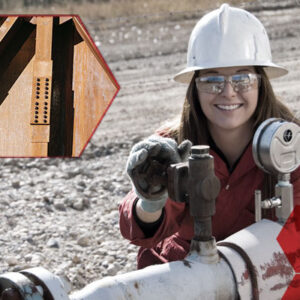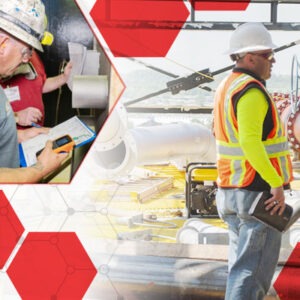Corrosion in Reinforced Concrete:- A details understanding
Reinforced concrete is a fundamental material in modern construction, known for its strength, durability, and versatility. It combines the compressive strength of concrete with the tensile strength of steel reinforcement, making it ideal for a wide range of structures, from bridges and highways to buildings and industrial facilities. However, despite its many advantages, reinforced concrete is susceptible to a significant issue: corrosion.
Corrosion of the embedded steel reinforcement can compromise the structural integrity and longevity of concrete structures, leading to costly repairs and potential safety hazards. Understanding the causes, mechanisms, and effects of corrosion in reinforced concrete is essential for developing effective prevention and mitigation strategies, ensuring the durability and safety of these critical infrastructures.
Definition of Reinforced Concrete
Reinforced concrete is a composite material made of concrete and steel reinforcement bars (rebars). The combination of these two materials results in a robust and durable construction material, as concrete provides compressive strength while steel offers tensile strength. This synergy makes reinforced concrete a preferred choice in modern construction.
Importance of Reinforced Concrete in Construction
Reinforced concrete, renowned for its versatility, strength, and durability, plays a critical role in the construction industry. It is utilized in a vast array of structures, including buildings, bridges, highways, and dams. Its ability to withstand various stresses makes it indispensable for constructing long-lasting and stable infrastructures. However, one significant challenge that often plagues reinforced concrete is corrosion.
Corrosion in reinforced concrete occurs when the steel reinforcement within the concrete is exposed to moisture and oxygen, leading to rust formation. This corrosion can weaken the structure over time, compromising its integrity and lifespan. Therefore, proper measures, such as the use of corrosion-resistant materials and regular maintenance, are essential to mitigate this issue and ensure the longevity of reinforced concrete structures.
Overview of Corrosion Issues in Reinforced Concrete
Corrosion in reinforced concrete is a significant concern that can compromise the structural integrity and lifespan of buildings and other structures. When the steel reinforcement within the concrete begins to corrode, it leads to the formation of rust, which expands and causes cracking and spalling of the surrounding concrete.
This not only weakens the structure but also increases maintenance and repair costs. Addressing the issue of corrosion in reinforced concrete is crucial for ensuring the longevity and safety of constructions. Preventative measures, such as using corrosion-resistant materials and applying protective coatings, are essential in mitigating these problems.
Environmental Factors
Exposure to Chlorides: Chloride ions from sources like de-icing salts or seawater can penetrate concrete and reach the reinforcing steel, initiating corrosion.
Carbonation Process: Carbon dioxide from the atmosphere reacts with calcium hydroxide in concrete, forming calcium carbonate. This reduces the alkalinity of concrete, leading to corrosion of the reinforcement.
Material Factors
Quality of Concrete and Permeability: Poor quality concrete or high permeability allows aggressive substances like water and chlorides to penetrate more easily, accelerating corrosion.
Type and Quality of Reinforcing Steel: The composition and quality of the steel used for reinforcement can influence its susceptibility to corrosion. Low-quality or improperly coated steel is more prone to corrosion.
Design and Construction Practices
Inadequate Cover to Reinforcement: Insufficient concrete cover over the reinforcement exposes it to environmental factors, increasing the risk of corrosion.
Poor Construction Practices: Improper concrete placement, compaction, or curing can create voids, cracks, or weak spots in the concrete, facilitating the ingress of corrosive agents and promoting corrosion of the reinforcement.
Addressing these factors through proper design, material selection, construction techniques, and maintenance practices is crucial for mitigating corrosion in reinforced concrete structures and ensuring their long-term durability.
Mechanism of Corrosion
Anodic and Cathodic Reactions
- Anodic Reaction: Iron metal loses electrons, forming iron ions.
- Cathodic Reaction: Oxygen from water or air gains electrons, forming hydroxide ions. These reactions occur simultaneously, leading to the breakdown of iron and the production of iron ions and hydroxide ions.
Formation of Rust and its Expansion
- Iron ions react with water and oxygen to form iron hydroxide, which dehydrates to form iron oxide (rust).
- Rust continues to form and expand, weakening the iron structure over time.
Chloride Ion Penetration and its Impact
- Chloride ions can penetrate through protective layers on iron surfaces, accelerating corrosion.
- Chlorides react with iron ions to form more soluble compounds, facilitating the dissolution of iron and the spread of corrosion.
Carbonation Process
- Carbon dioxide from the atmosphere can penetrate through water and react with water to form carbonic acid.
- Carbonic acid reduces the pH of water, making it more acidic.
- Lower pH levels increase the rate of corrosion by accelerating the dissolution of iron ions.
Effects of Corrosion on Reinforced Concrete
Loss of Bond Between Steel and Concrete: Corrosion in reinforced concrete of the steel reinforcement can lead to the formation of rust, which occupies a greater volume than the steel itself, causing it to expand. This expansion can result in the separation of the steel from the surrounding concrete, compromising the bond between them. This loss of bond reduces the effectiveness of the reinforcement in providing structural support.
Reduction in Cross-Sectional Area of Reinforcement: As corrosion in reinforced concrete progresses, the steel reinforcement gradually loses material due to rusting. This reduction in cross-sectional area weakens the reinforcement, diminishing its ability to resist tensile stresses and compromising the overall structural capacity of the concrete element.
Durability and Longevity
Cracking and Spalling of Concrete: Corrosion-induced expansion of the steel reinforcement in reinforced concrete can exert pressure on the surrounding concrete, leading to cracking and spalling. These cracks provide pathways for moisture and aggressive chemicals to penetrate deeper into the concrete, accelerating the corrosion process and further compromising the structure’s integrity.
Increased Maintenance Costs: Corrosion-related damage necessitates regular inspection and maintenance to mitigate further deterioration. Repairing corroded reinforcement and damaged concrete, applying protective coatings, and implementing corrosion prevention measures can incur significant costs over the lifespan of the structure. Additionally, corrosion-induced structural deficiencies may require costly remedial measures to ensure the safety and longevity of the reinforced concrete elements.
Detection and Assessment of Corrosion
Visual Inspection
Signs of Corrosion: Visual inspection involves examining the surface of the concrete structure for visible signs of corrosion in reinforced concrete, such as cracks, rust stains, and spalling. These indicators often provide initial clues about the presence and extent of corrosion-related damage.
Half-Cell Potential Measurements: This method involves using a half-cell electrode to measure the electrochemical potential of the steel reinforcement relative to a reference electrode. Variations in potential can indicate the presence and severity of corrosion at different locations within the concrete.
Resistivity Measurements: By assessing the electrical resistivity of concrete, which is influenced by factors such as moisture content and the presence of corrosion products, resistivity measurements can help identify areas prone to corrosion in reinforced concrete and assess the overall condition of the concrete.
Ground-Penetrating Radar (GPR): Ground-penetrating radar (GPR) uses electromagnetic waves to detect variations in material properties and locate embedded objects within concrete structures. It can identify areas of corrosion-induced delamination, voids, or reinforcement corrosion without damaging the structure. GPR is particularly effective for detecting corrosion in reinforced concrete.
Sampling and Laboratory Analysis: Destructive testing involves extracting core samples from the concrete structure for laboratory analysis, particularly in cases of corrosion in reinforced concrete. These samples can be analyzed to determine the chloride ion concentration, pH levels, and presence of corrosion products in the concrete. This information helps assess the extent of corrosion damage and formulate appropriate repair and maintenance strategies.
Preventing and mitigating
Use of Corrosion-Resistant Materials: Selecting corrosion-resistant materials such as epoxy-coated rebar or stainless steel reinforcement can significantly reduce the susceptibility of the structure to corrosion. These materials provide a protective barrier against corrosive agents and help prevent the initiation and progression of corrosion.
Adequate Concrete Cover and Proper Mix Design: Ensuring sufficient concrete cover over the reinforcement and utilizing appropriate mix designs with low permeability can enhance the durability of the concrete and inhibit the ingress of moisture, chlorides, and other corrosive substances to the reinforcement, thus mitigating corrosion in reinforced concrete.
Protective Coatings and Sealers
Application of Surface Sealers and Coatings: Surface sealers and coatings can be applied to the concrete surface to create a protective barrier against moisture, chlorides, and other corrosive elements. These coatings help prevent the initiation of corrosion and extend the service life of the structure.
Cathodic Protection
Sacrificial Anode Systems: Sacrificial anode systems involve attaching sacrificial anodes, typically made of materials like zinc or aluminum, to the steel reinforcement. These anodes corrode preferentially, diverting corrosive currents away from the reinforcement and providing protection against corrosion.
Impressed Current Systems: Impressed current systems, a vital solution in combating corrosion in reinforced concrete, utilize an external power source to generate a protective electrical current that counteracts the corrosive processes occurring on the reinforcement. This method offers more precise control over the protection level and is often used in larger or more complex structures.
Maintenance and Monitoring
Regular Inspections and Maintenance: Implementing a proactive maintenance program involving regular inspections and repairs can help identify and address corrosion-related issues before they escalate. Prompt repair of cracks, spalls, and damaged coatings can prevent corrosion initiation and progression.
Implementation of Corrosion Monitoring Systems: Installing corrosion monitoring systems, such as embedded sensors or remote monitoring devices, allows for continuous monitoring of corrosion activity within the structure, particularly in corrosion in reinforced concrete. Early detection of corrosion-related changes enables timely intervention and maintenance, ultimately preserving the integrity and longevity of the reinforced concrete elements.
Frequently Asked Questions
What is reinforced concrete?
Reinforced concrete is a composite material made of concrete and reinforcing steel. The concrete provides compressive strength, while the steel reinforcement provides tensile strength, making the material suitable for various structural applications.
Why does corrosion occur in reinforced concrete?
Corrosion occurs in reinforced concrete primarily due to environmental exposure, material properties, and construction practices. Factors such as exposure to chlorides, carbonation, inadequate concrete cover, and poor-quality materials contribute to the onset and progression of corrosion.
How do chlorides cause corrosion in reinforced concrete?
Chlorides, from sources like de-icing salts and seawater, penetrate the concrete and reach the steel reinforcement. They disrupt the passive oxide layer protecting the steel, initiating an electrochemical reaction that leads to rust formation and subsequent expansion, which can crack the surrounding concrete.
What are the signs of corrosion in reinforced concrete?
Signs of corrosion include cracking, rust stains on the surface, spalling (flaking or breaking off) of concrete, and visible rust on exposed steel reinforcement.
Closing Insights
Corrosion in reinforced concrete is a critical issue that demands attention and proactive measures to ensure the longevity and safety of our infrastructure. From understanding the causes and mechanisms to implementing effective detection and mitigation strategies, addressing this challenge requires a comprehensive approach. At Corcon Institute of Corrosion, we are dedicated to advancing knowledge and providing innovative solutions for corrosion control. Our expertise in corrosion in reinforced concrete helps engineers, architects, and construction professionals develop and maintain structures that stand the test of time. By focusing on cutting-edge research and practical applications, Corcon aims to lead the way in combating corrosion in reinforced concrete, ensuring a safer and more durable built environment for future generations. Join us in our mission to protect and preserve the integrity of reinforced concrete structures through education, research, and collaboration.
Image Reference: Freepik
Disclaimer: All trademarks, logos, and brand names are the property of their respective owners. All company, product, and service names used in this website are for identification purposes only. Use of these names, trademarks, and brands does not imply endorsement.






